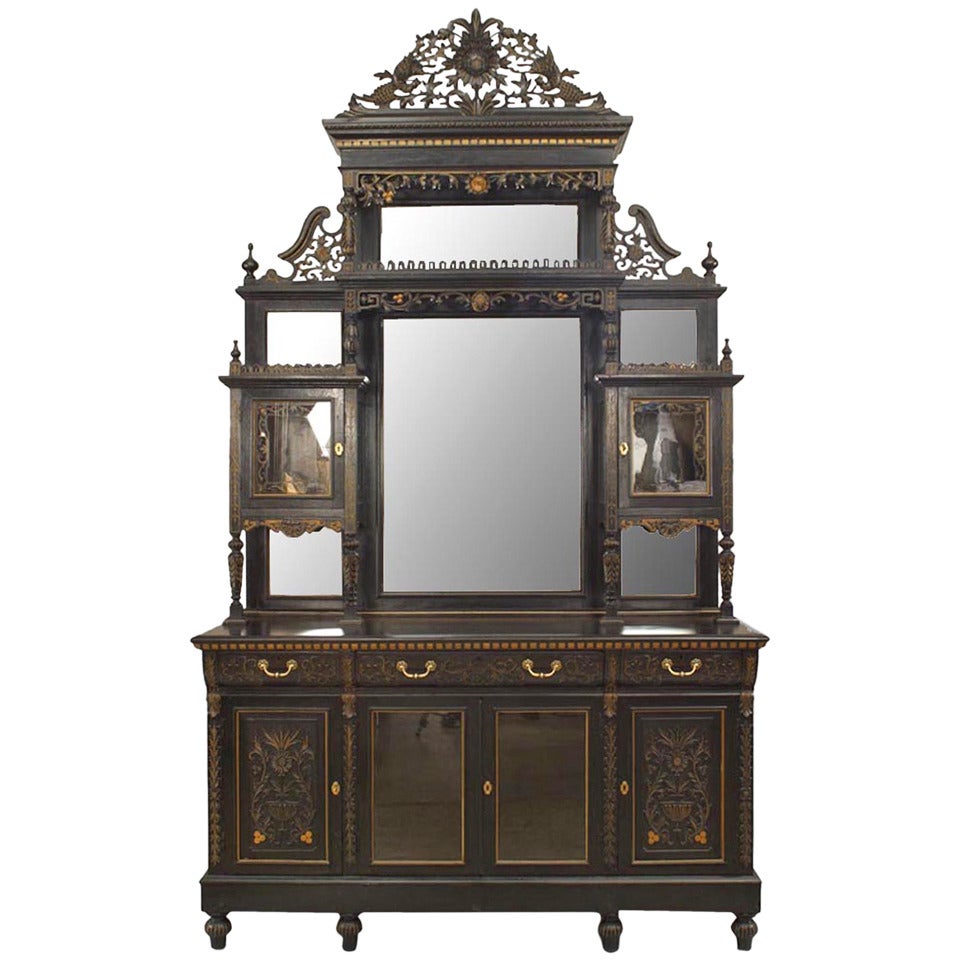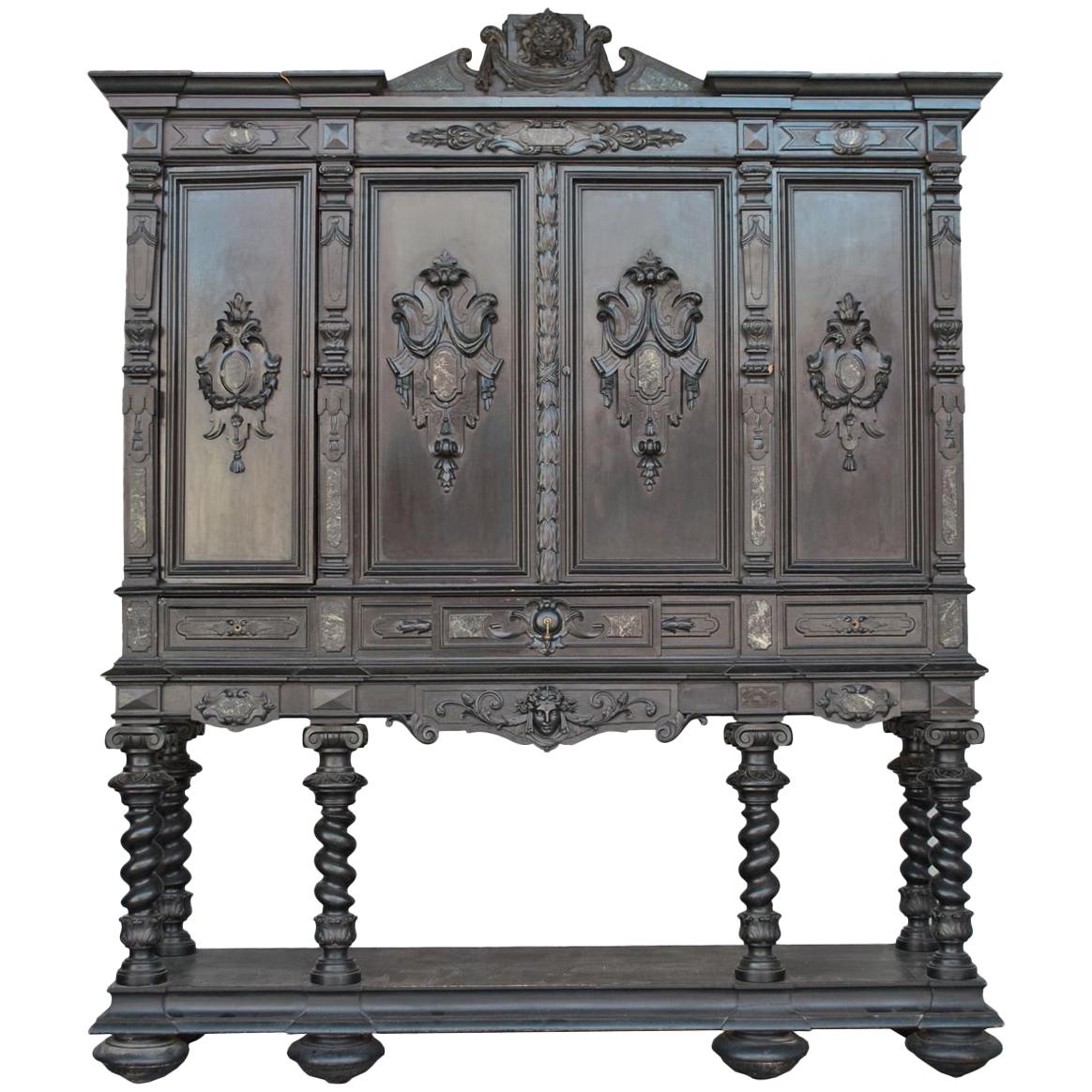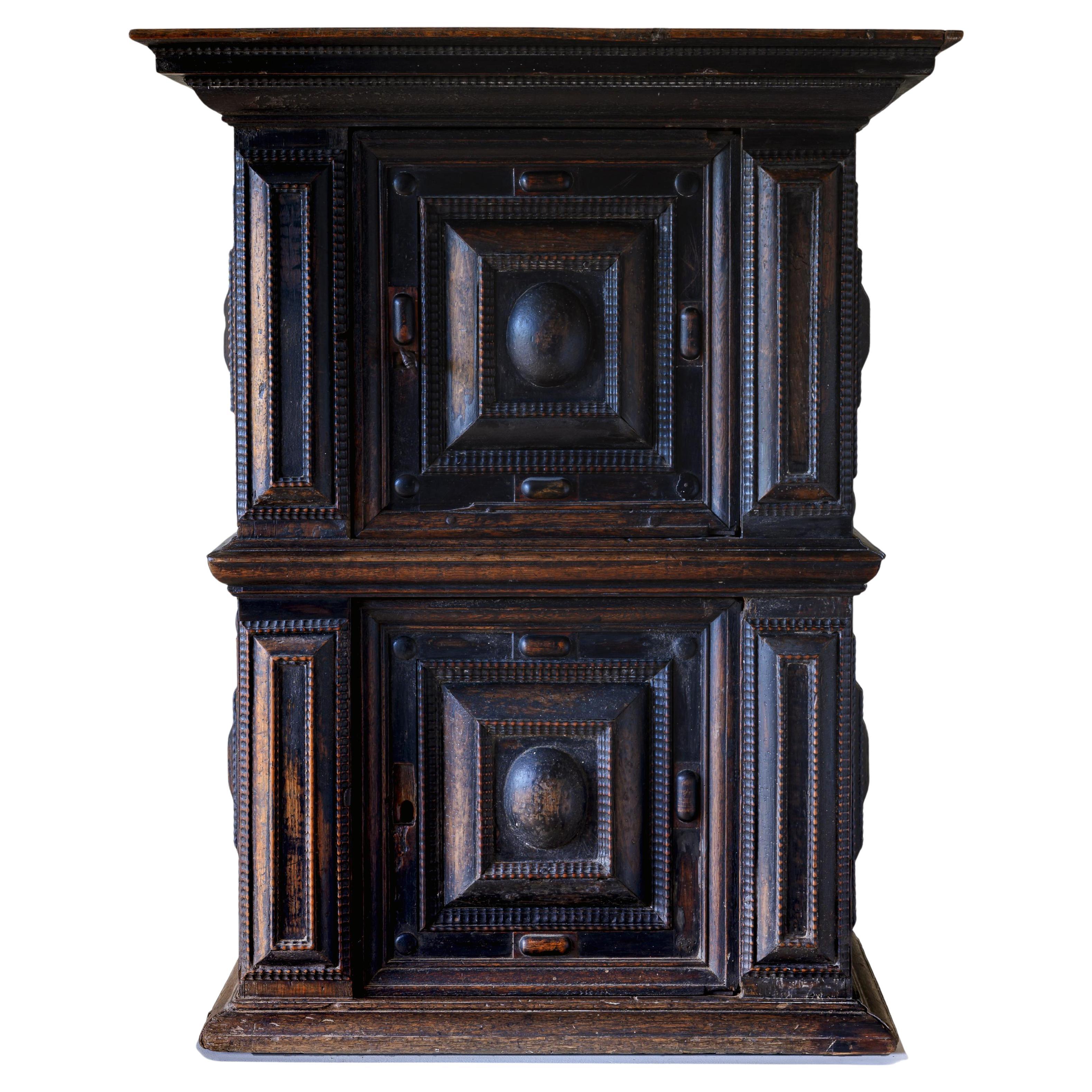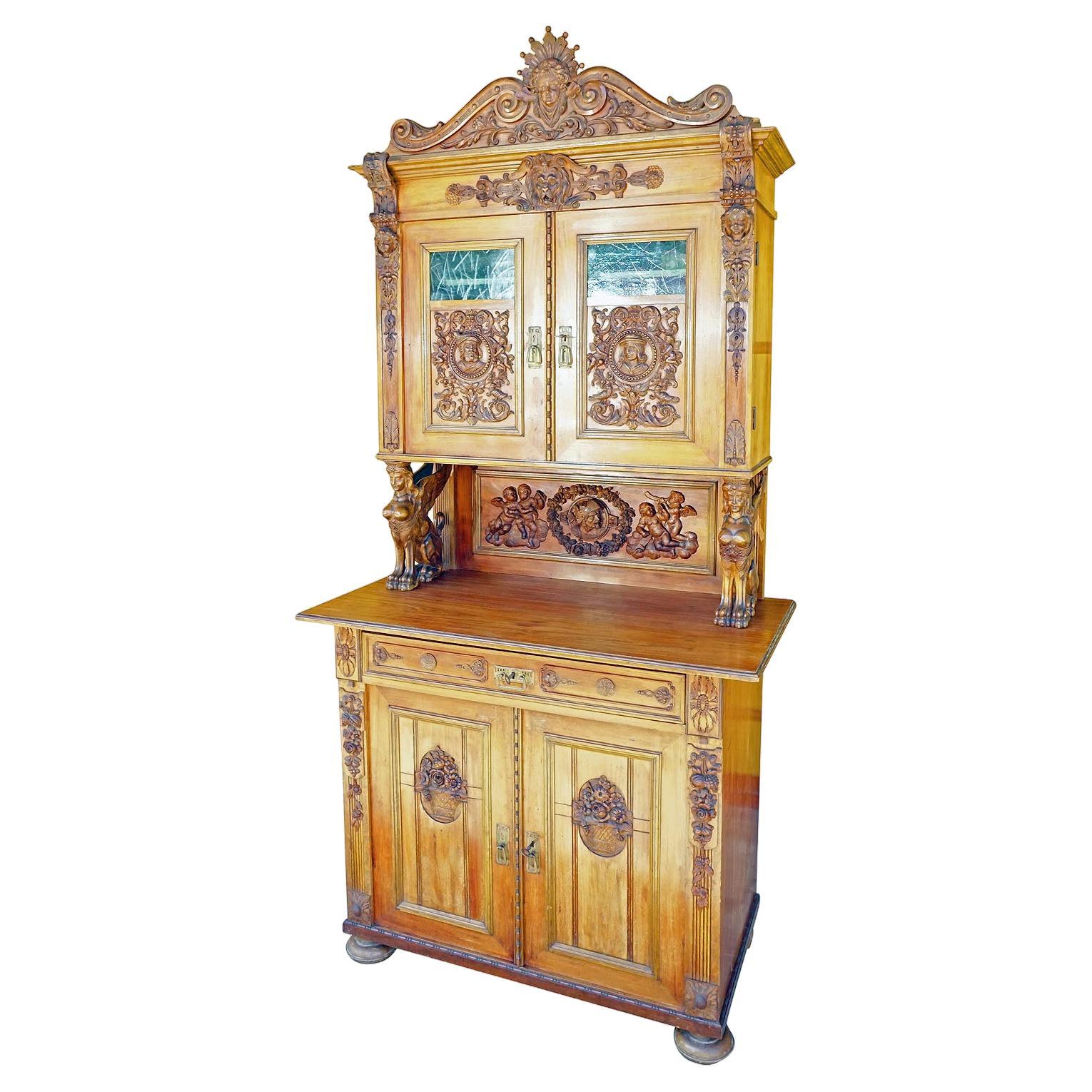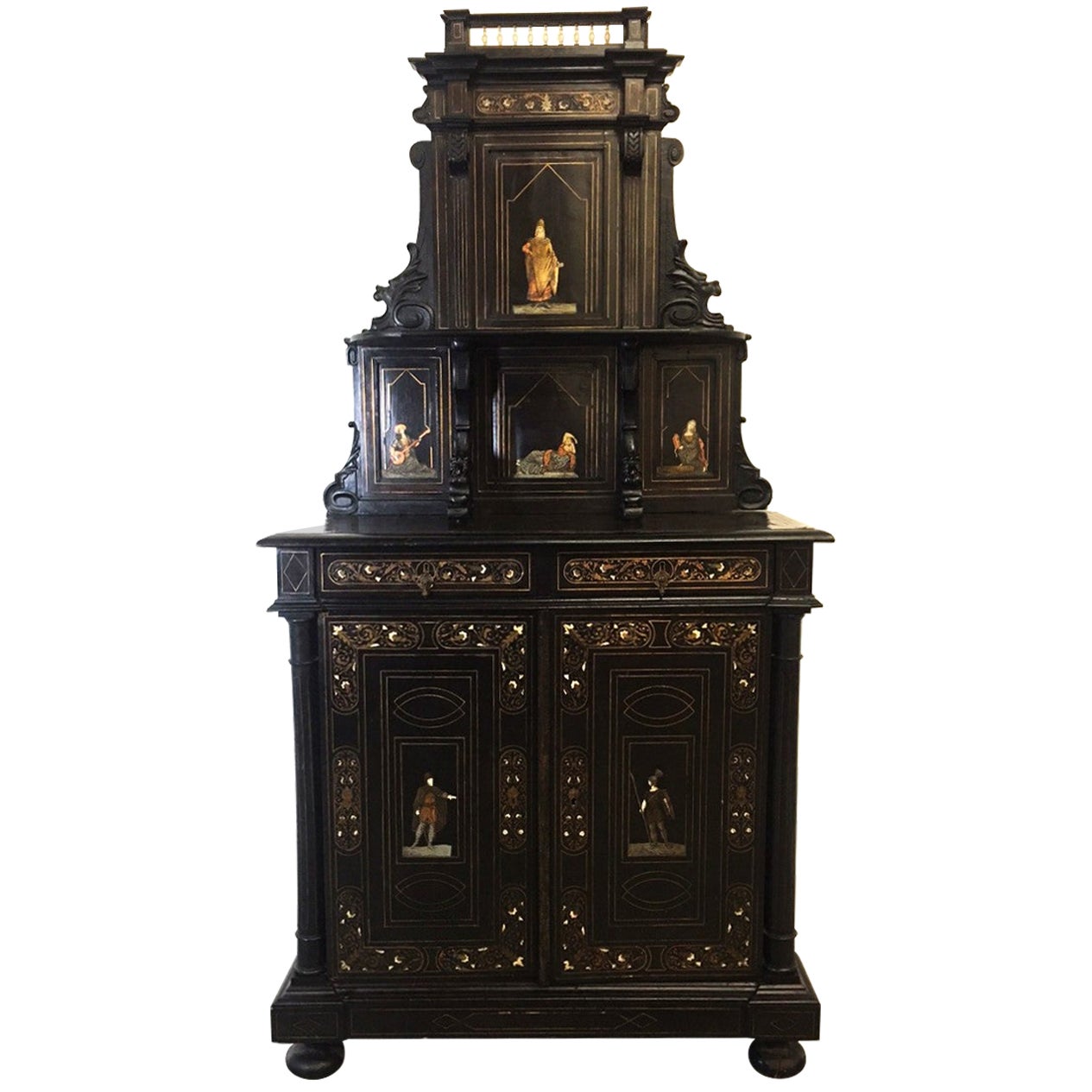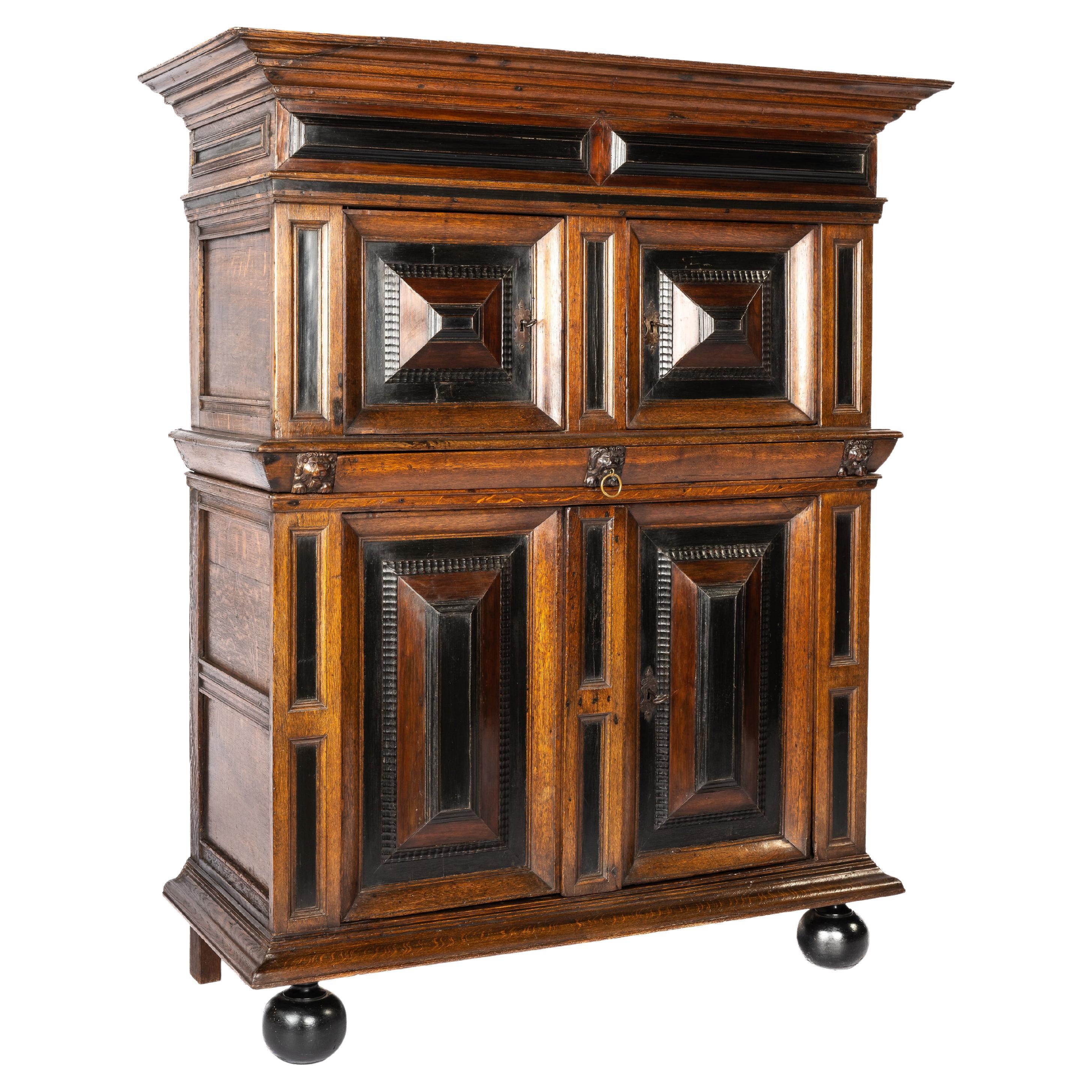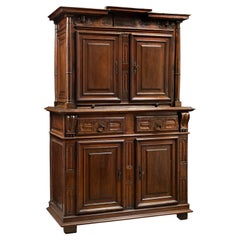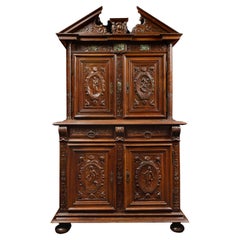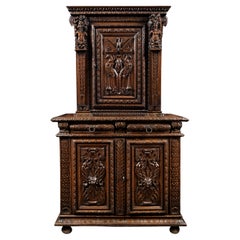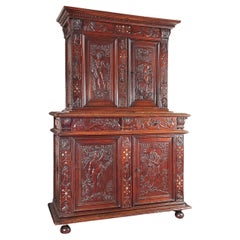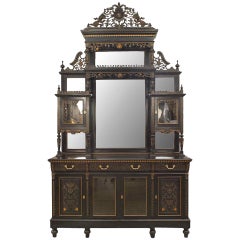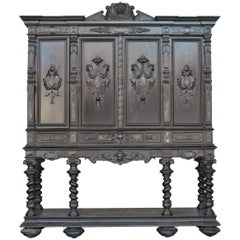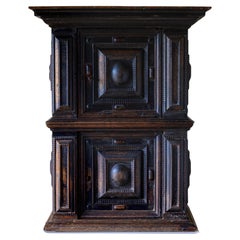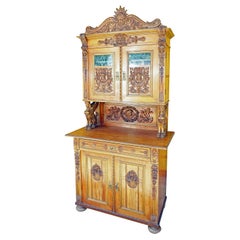Items Similar to Important Cabinet with Two Body in Blackened Wood Carved and Engraved
Want more images or videos?
Request additional images or videos from the seller
1 of 7
Important Cabinet with Two Body in Blackened Wood Carved and Engraved
$27,548.02
£20,414.59
€23,000
CA$37,608.27
A$41,837.67
CHF 21,931.83
MX$511,246.07
NOK 279,274.48
SEK 262,898.29
DKK 175,119.98
Shipping
Retrieving quote...The 1stDibs Promise:
Authenticity Guarantee,
Money-Back Guarantee,
24-Hour Cancellation
About the Item
IMPORTANT CABINET WITH TWO BODY IN BLACKENED WOOD CARVED AND ENGRAVED
ORIGIN: FRANCE
PERIOD: 17TH CENTURY
Height: 188 cm
Width: 135 cm
Depth: 53.5 cm
Blackened wood and veneer: rosewood, ebony, pear, mahogany
Framed in oak wood
A real ceremonial piece of furniture, this two-part cabinet opens with two historiated panels and two drawers in the upper part and two leaves and two belt drawers in the lower part.
Richly worked, it offers both inside and outside a floral decoration, finely engraved which contrasts with the importance given to geometric lines. This duality, typical of this type of cabinet, confirms its dating and its origin.
In addition, the gilded metal locks and fittings enhance the sumptuous trait of this piece of furniture and also contribute to its ornamentation.
Furniture of predilection for “enclosing the most precious things” (Furetière, Dictionnaire, 1690) the appearance of cabinets in the 16th century accompanied the development of wunderkammern, these cabinets of curiosities enriched both by the vogue for the antique and by distant expeditions which bring back with them natural wonders and rare testimonies of distant civilisations. The curious, combining fortune and culture, brings together antique medals, rare plants, fossils, or oriental ornaments. This meeting of pieces which embodies much more than their material reality, a subjective evocation of all the riches of the earth and all the knowledge of men, acts in the eyes of its owner like a microcosm of which he is the master and which he enjoys according to his will.
This is how the first cabinets were designed to be transportable, often wooden structures calling for riches only those they housed for a collector who refused to part with them, even temporarily.
In the 17th century, the cabinet gained in technical complexity and luxurious materials until it could no longer be moved itself and became a prized and expensive collector’s item that was found to varying degrees in the homes of the as well as the prince.
Kept in the eponymous room of the apartment, intimate and reduced, the cabinet creates a mise en abyme among the rest of the collection which continues beyond the piece of furniture, lining the bedroom (Kammer). Indeed, in the 27 drawers of this cabinet was conserved a collection in the collection, perhaps archaeological fragments or shells from overseas, perhaps refined perfumes or precious jewels.
Cultivating the taste for merit and surprise specific to the curious, the manipulation of the cabinet obeyed three stages.
Closed, in the upper part, it offers two scenes in bas-relief carved in geometric medallions around which are inscribed geometric cartouches with a motif of finely engrave foliage scrolls.
On the lefts leaf is what could be a triumphal entry of a king into the city. A royal entrance is defined by the historian Pascal Lardellier as a major political rite consisting “for a city to officially welcome a sovereign or a high dignitary, in an architectural and theatrical setting prepared for the occasion”. We see a rider richly dressed in the Roman style carrying a sceptre, surrounded by two dancing musicians. In the background, we can see two men at a window watching the show.
The opposite medallion presents a scene that is more difficult to identify. We see a Roman soldier and two men talking. On the left, a boat taked shape which can make us say that the scene is held in a port. In the distance, the city emerges with its tower and its dome.
The character on the right, richly dressed, a sword at his waist, carries a sceptre in his left hand and points to the city with his right hand. The character on the left has in his right hand the same hat than the character described above. He seems to point to the ship. In the centre, the Roman soldier recognizable by his armor, his helmet and his spear listens to the first character. Maybe it is a commercial scene ?
Once the two leaves are open, 14 drawers are revealed framing two leaves engraved with a fruit basket from which a flower rises. The interior of the main leaves is also engraved and uses the same fruit and flower basket pattern with a few variations.
Finally, the last opening reveals a luminous space reproducing in wood marquetry, a theatre. This feigned structure, reminiscent in its polychromy of the churches of Tuscany, is framed by nine small drawers. In the upper part of the alcove, at the base of the opening as well as on the reverse of the two leaves, is a rose-des-vents in marquetry. To accentuate the effect of perspective, a checkerboard is created at the base of the alcove and leads the eye to a landscape painted on wood which is reflected in the two mirrors arranged on either side of the representation.
The cabinet surprises with its well-executed ornamentation which exploits historiated reliefs, plays of light and coloured marquetry, preserved in an exemplary manner.
- Dimensions:Height: 136 in (345.44 cm)Width: 135 in (342.9 cm)Depth: 53.5 in (135.89 cm)
- Materials and Techniques:
- Period:
- Date of Manufacture:17th Century
- Condition:Repaired. Wear consistent with age and use. Minor losses. Minor structural damages.
- Seller Location:Saint-Ouen, FR
- Reference Number:1stDibs: LU3115336035272
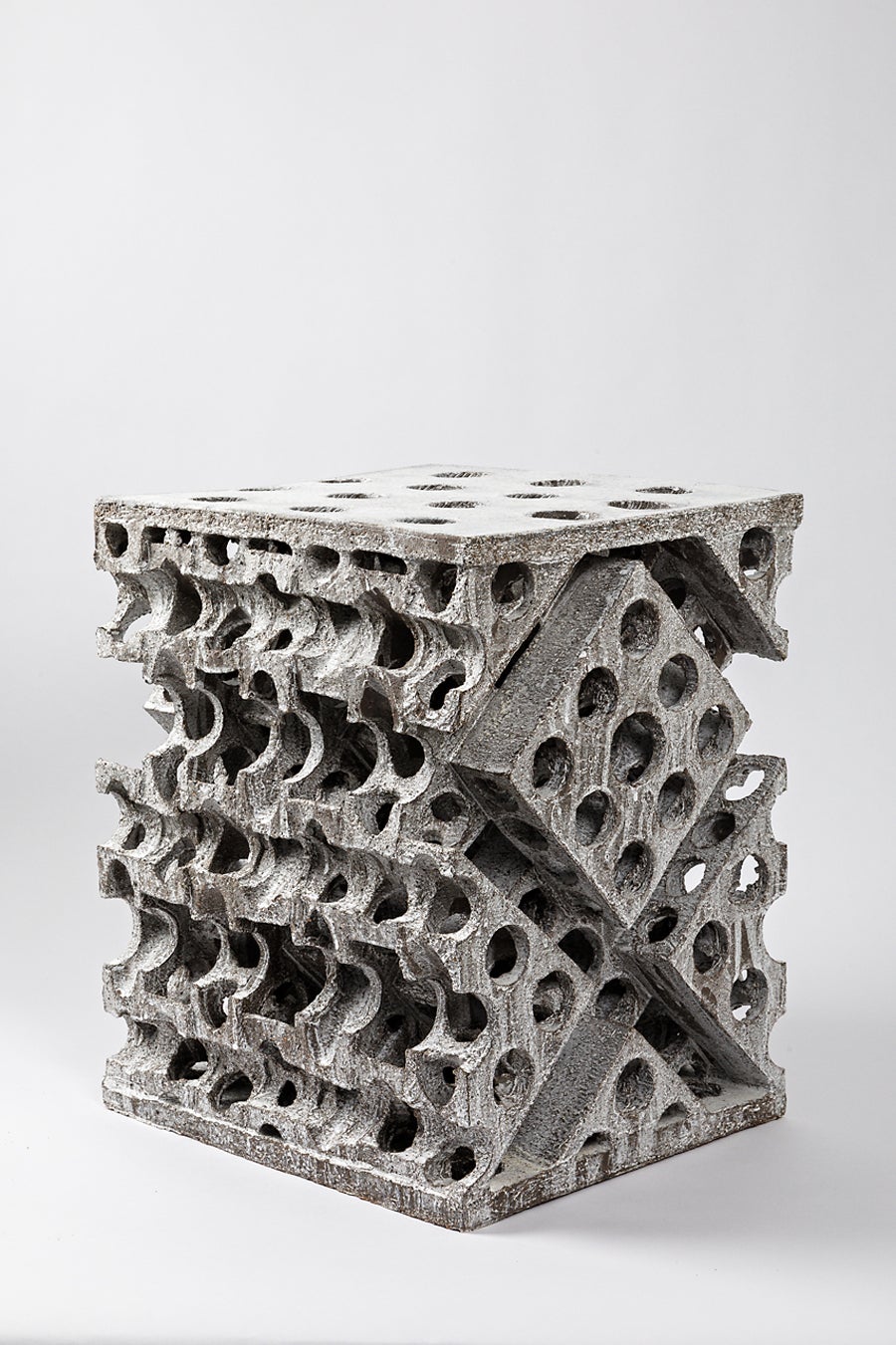
About the Seller
5.0
Vetted Professional Seller
Every seller passes strict standards for authenticity and reliability
Established in 2016
1stDibs seller since 2017
189 sales on 1stDibs
Typical response time: 3 hours
- ShippingRetrieving quote...Shipping from: Paris, France
- Return Policy
Authenticity Guarantee
In the unlikely event there’s an issue with an item’s authenticity, contact us within 1 year for a full refund. DetailsMoney-Back Guarantee
If your item is not as described, is damaged in transit, or does not arrive, contact us within 7 days for a full refund. Details24-Hour Cancellation
You have a 24-hour grace period in which to reconsider your purchase, with no questions asked.Vetted Professional Sellers
Our world-class sellers must adhere to strict standards for service and quality, maintaining the integrity of our listings.Price-Match Guarantee
If you find that a seller listed the same item for a lower price elsewhere, we’ll match it.Trusted Global Delivery
Our best-in-class carrier network provides specialized shipping options worldwide, including custom delivery.More From This Seller
View All16th Century Renaissance Two-Bodied Cabinet
Located in Saint-Ouen, FR
Former collection Altounian
At the beginning of the reign of Henri II (1547-1559) the furniture’s ornamentation evolves. The few medieval motifs that were still used are eventually relinquished. Furniture becomes more sober showcasing moulded panels and perfect architecture. Cabinet-makers use ornaments such as curved fluted or plain columns, feather quills, roses or winged putti heads. High-relief carving becomes more scarce and compositions lighter. To that end cabinet-makers draw inspiration from Fontainebleau motifs filtering them and adapting them to French taste.
During this period cabinet-makers turn into a kind of architects. Indeed the architectural balance of furniture is the centre of their concerns. The study of Antic formulas is then a necessity. From this care given to proportions appear refined cabinets with pure lines.
This style is characteristic of the reign of Henri II and disappears soon after under the regency of Catherine de Medici (1560-1574) when an abundance of high and low-relief ornaments comes back on furnitures.
This two-bodies cabinet...
Category
Antique 16th Century French Renaissance Cabinets
Materials
Walnut
16th Century French Walnut Cabinet with Marble Inlays
Located in Saint-Ouen, FR
On the left post of the lower body, is written the date 1596 in a cartouche
This cabinet has two bodies. The upper part, set back, is moulded and carved. At the bottom, the cabine...
Category
Antique 16th Century French Renaissance Cabinets
Materials
Walnut
16th Century French Carved Renaissance Cabinet
Located in Saint-Ouen, FR
Rare carved Renaissance cabinet
Period : 2nd half 16th century, ca. 1570
Origin : France, Burgundy or Languedoc
This cabinet embody the produ...
Category
Antique 16th Century French Renaissance Cabinets
Materials
Walnut
Rare Renaissance Cabinet Richly Carved
Located in Saint-Ouen, FR
This rare Renaissance cabinet is richly decorated on the doors and drawers with carvings depicting the four seasons, and on the uprights and the entablature, alternating flower bouquets inlaid with mother of pearl. This is a beautifully conceived piece of furniture, representing a crowned portico with its entablature and cornice.
The upper body
Articulated separately in a ternary rhythm, as with the lower body, the upper part opens with two carved doors. The doors are framed by both the lateral uprights and the casing. There are cartouches carved into the casing in which mythological figures are depicted with flower bouquets.
On the doors:
On the right: Spring, a female figure crowned with a wreath of leaves, holding a basket full of flowers. She is wearing necklaces and bracelets on each arm, with drapery discretely wrapped around her body and is standing on a winged putti’s head. On each side are depicted a tree and a village with a steepled church. Above her head floats the three signs of the zodiac corresponding to the season: Aries, Taurus and Gemini.
On the left: Summer, a bearded man crowned with ears of corn and bearing armfuls of corn. He is standing on a similar winged putti, flanked by a tree and an ear of corn. The following three signs of the zodiac appear: Cancer, Leo and Virgo.
On the uprights and the central casing a number of smaller figures seem to represent virtues and vices that newly wedded couples should aspire to and avoid.
On each side, at the bottom of the uprights, there is a dog representing fidelity. Above, a lion embodies power, wisdom, and justice.
In between, on the left upright, there is a figure of noncombatant Athena wearing a helmet and holding a spear, an arrow pointing down and in her left hand, a shield, symbol of protective power. On the right upright, the goddess Venus controls the arrow of Cupid.
The iconography here acts as a clear reminder of the required virtues that both parts of a young couple need to fulfill: fidelity, power, wisdom and justice. For him, the goddess Athena focuses on the power. Whereas for her, it is Venus who shows how to control Cupid’s arrow.
On the central casing at the bottom, by way of contrast, there is a peacock, a symbol of pride and at the top, a monkey representing lust and mischief. In between, a woman holding a chain and a cup full of precious stones while on the floor sits a half empty opened casket. This can be interpreted as a symbol of extravagance.
Above, the entablature, decorated with male figures resting on leaking urns, may symbolize the passing of time. They are flanked by two consoles decorated with acanthus leaves and separated by flower bouquets (inlaid with mother of pearl). Finally on top, a cornice acts as a crown for the piece of furniture.
The lower body
The moulded base stands on four round, flattened feet.
Represented on the doors:
On the left: Autumn, a stocky, naked man crowned with vine leaves, holding fruits in his right hand and with his left, picking a bunch of grapes from a climbing vine. Standing on a mound, he is surrounded by a vine and a hill, at the foot of which a man presses the grapes in a big vat after the harvest. Above the climbing vine appear the signs of Libra, Scorpio and Sagittarius.
On the right: Winter, an elderly man wearing a fur cloak...
Category
Antique 16th Century French Renaissance Cabinets
Materials
Walnut
Exceptional Cabinet known as the Sumene Cabinet
Located in Saint-Ouen, FR
EXCEPTIONAL CABINET KNOWN AS THE SUMÈNE CABINET
ORIGIN : FRANCE, NÎMES
PERIOD : 16th CENTURY
Height: 199 cm
Width: 180.5 cm
Depth: 69 cm
Walnut wood
Good state of preservation
...
Category
Antique 16th Century French Renaissance Cabinets
Materials
Wood, Walnut
Small Renaissance Cabinet from Lyon
Located in Saint-Ouen, FR
Small renaissance cabinet from Lyon.
ORIGIN: FRANCE, SCHOOL OF LYON
PERIOD: 16th CENTURY
Height:151cm
Depth: 120cm
Length: 54cm
Walnut ...
Category
Antique 16th Century Cabinets
Materials
Walnut
You May Also Like
English Ebonized Cupboard Cabinet
Located in Queens, NY
English Aesthetic Movement (19th Century) ebonized cupboard cabinet with gold incised and floral carved trim and mirrored back panels on upper section with filigree pediment top.
Category
Antique 19th Century English Aesthetic Movement Cabinets
Materials
Gold
19th Century Renaissance Style Important Blackened Wooden Cabinet
Located in Marseille, FR
Chateau furniture: Important blackened wooden cabinet in Renaissance style with twisted columns. Richly carved. Decor with heads of women and lion. French cabinetmaker work, 19th cen...
Category
Antique 19th Century French Renaissance Cabinets
Materials
Wood
Remarkable Late 17th Century Swedish Baroque Cabinet
Located in Bozeman, MT
Remarkable and rare late 17th century ebonized Baroque cabinet in it's original finish with wonderful patination. Ca 1690 Sweden, possibly Norway. (pedestal not included).
Category
Antique 17th Century Swedish Baroque Cabinets
Materials
Wood
Antique Wooden Carved Cupboard with Several Carvings
Located in Berghuelen, DE
Antique Wooden Carved Cupboard with Several Carvings
A detailed handcarved wooden buffet or cupboard with several elaborately carved wooden decorations depicting lion, putties, ange...
Category
Early 20th Century German Black Forest Cabinets
Materials
Wood
Italian Ebonized High-Back Sideboard, Inlaid
Located in Pomona, CA
This is an Italian high-back Server or sideboard with an ebonized finish. All inlaid with brass and bone. The string inlays are brass also. The painted panels depict figures in perio...
Category
Antique Late 19th Century Italian Sideboards
Materials
Brass
Antique 17th Century Dutch Renaissance Solid Oak with Ebony Veneer Cupboard
Located in Casteren, NL
This beautiful and friendly-sized cupboard is made of the finest watered oak in the tradition of the Dutch Renaissance during the “Dutch golden age” It is a two-story four-door cabin...
Category
Antique 17th Century Dutch Renaissance Cabinets
Materials
Ebony, Oak
More Ways To Browse
Entry Cabinet
Engraved Shell
Used Casement Window
Carved Wood Medallion
Carved Wood Plant
Floral Carved Wood Cabinets
Wood Carved Fruit
17th Century Carved Cabinet
Carved Shell Cabinet
Wood Soldier
Wood Bas Relief
Wood Sword
Used Casement Windows
Fruit Cabinet
Watch Cabinet
Antique Casement Windows
Carved Wood Hat
Floral Carved Oak Cabinet
